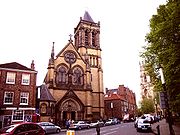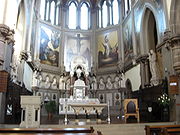
St Wilfrid's York
Encyclopedia

York
York is a walled city, situated at the confluence of the Rivers Ouse and Foss in North Yorkshire, England. The city has a rich heritage and has provided the backdrop to major political events throughout much of its two millennia of existence...
, England
England
England is a country that is part of the United Kingdom. It shares land borders with Scotland to the north and Wales to the west; the Irish Sea is to the north west, the Celtic Sea to the south west, with the North Sea to the east and the English Channel to the south separating it from continental...
, in the shadows of York Minster
York Minster
York Minster is a Gothic cathedral in York, England and is one of the largest of its kind in Northern Europe alongside Cologne Cathedral. The minster is the seat of the Archbishop of York, the second-highest office of the Church of England, and is the cathedral for the Diocese of York; it is run by...
. A Church dedicated to St. Wilfrid has stood in York since medieval times. Catholics call it the "Mother Church of the city of York." It is in Gothic Revival style. The Arch over the main door has the most detailed Victorian carving in the city. The present Church was completed in 1864 and it was considered to be one of the most perfectly finished Catholic Churches in England, rich in sculptures, paintings and stained glass.
It is part of the Roman Catholic Diocese of Middlesbrough
Diocese of Middlesbrough
The Roman Catholic Diocese of Middlesbrough is a Latin Rite Roman Catholic diocese based in Middlesbrough, England and is part of the province of Liverpool. It was founded on 20 December 1878, with the splitting of the Diocese of Beverley which had covered all of Yorkshire...
and was the second pro-Cathedral of the Diocese of Beverley
Diocese of Beverley
The Diocese of Beverley is an historical diocese of the Roman Catholic Church in England. It took its name after the town of Beverley in the East Riding of Yorkshire. The diocese was established in 1850 and was replaced by two dioceses in 1878...
until its dissolution in 1878.
History
In 1585 the parish could not support itself (possibly due to the large number of churches in York). The Church became redundant and was demolished. It was eventually built over and the parish united with St. Michael-Le-Belfry. St. Wilfrid's parish was revived by York Catholics in 1742 when they established their Mission in Little Blake Street. The Mission was founded by the Vicar Apostolic of the Northern District of England, Edward Dicconson.A Catholic priest's house was established at number 7 Little Blake Street (now Duncombe Place) known as Chapel House. In 1760 the first public place of worship for Catholics opened in York. The chapel continued until 1802 when another chapel was built on the opposite side of the street (on the present site). At this time there were still strong anti-catholic feelings, so the chapel was hidden from the street by its presbytery. The chapel could hold 700 people and the Catholic population continued to increase in York.
Present church
A Church dedicated to St. Wilfrid has stood in York since medieval times. The original site of the Church was on land now occupied by the Judges Lodgings in Lendal and part of the Assembly Rooms behind in Blake Street.The present Church was completed in 1864 for the sum of £10,000. It was opened by Cardinal Wiseman in June 1864. It became a grade II listed building in 1968.
In 1848 plans were drawn up to build a new Church. The funds, however, were diverted to build a much needed Church in the Walmgate area for the large number of Irish Catholics who settled there during the potato famine. St. George's Church
St George's York
St. George's Roman Catholic church is located in the centre of the city of York, England, on George Street in the Diocese of Middlesbrough. The Church was designed by Joseph Hansom and was the first pro-Cathedral of the Diocese of Beverley....
was built and it became the Pro-Cathedral of the Catholic diocese of Beverley.
In 1859 York Corporation were planning a new approach road to Lendal Bridge. This prompted Dean Duncombe to apply to the corporation to continue the route by the chapel and towards the Minster. The old narrow lane (Lop Lane or Little Blake Street) was replaced with a wide thoroughfare. The houses on the opposite side to the chapel were demolished and the road widened to create Duncombe Place, named after the Dean.
St. Wilfrid's Church, as it stands today, was to be built on the site of the old chapel. The foundation stone was laid in April 1862 by Bishop Cornthwaite. The architect who designed the building was called George Goldie, son of a prominent parishioner Dr. Goldie. George Goldie was baptised in St. Wilfrid's chapel. He also designed St Wilfrid's Primary School nearby, however, he died in 1887 before the school was built.
The Church was designed in a Gothic Revival manner, a copy of 13th-14th century style. The arch over the main door has the most detailed Victorian carving in the city.
The Church was completed in 1864, costing around £10,000, and was opened by Cardinal Wiseman in June of that year. It was considered to be one of the most perfectly finished Catholic Churches in England, rich in sculpture and paintings and stained glass. It became the Pro-Cathedral Church of the Beverley Diocese. This was short lived as Beverley diocese was split to make the Dioceses of Leeds (South of the River Ouse) and Dioceses of Middlesbrough (North of the River Ouse). Nevertheless, St. Wilfrid's still stands as the "Mother Church of the city of York".
Part of the porch way believed to belong to the original St. Wilfrid's Church was found under the floor of the Assembly Rooms during the 19th Century renovations.
In 1945 Middlesbrough Diocese bought a 16th Century house in the Shambles. Number 35 is now the shrine of St. Margaret Clitherow. It is a pilgrimage site for Catholics from all over the world. Mass is celebrated here regularly every Saturday at 10.00am and it is open to visitors during the week.
Interior decoration

- High Altar
- Wall Paintings
- Altar Rails
The altar rails at St Wilfrid's were very fine and were of particular note. They were built by Wilfrid Dowson, from Kirkbymoorside, who was responsible for some work at York Minster, as well as the Queen's Gates at St George's Chapel in Windsor Castle
Windsor Castle
Windsor Castle is a medieval castle and royal residence in Windsor in the English county of Berkshire, notable for its long association with the British royal family and its architecture. The original castle was built after the Norman invasion by William the Conqueror. Since the time of Henry I it...
(http://archive.thisisyork.co.uk/2001/01/11/308060.html). The rails were removed in February 2007.
- Tower The tower is some 147 ft high and is visible around much of York. The clever design of the tower makes it appear as though St Wilfrid's is taller than the Minster in the background, it is only when a person has passed Wilfrid's that they can see the Minster is taller. Ten bells were added to the tower in 1995.
- Organ

